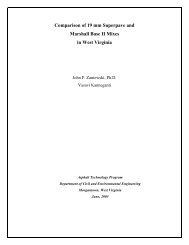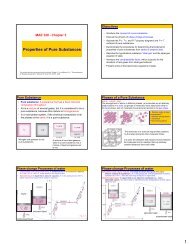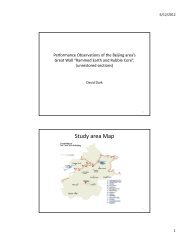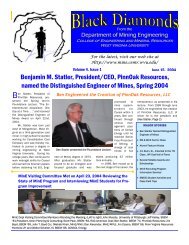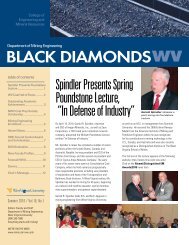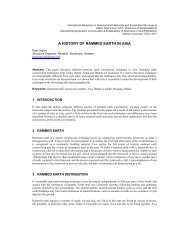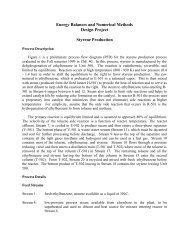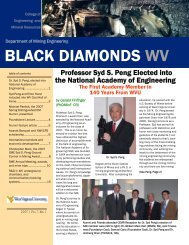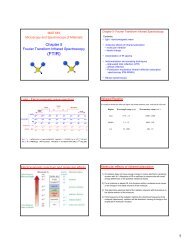Comparison of 9.5 mm SuperPave and Marshall Wearing I Mixes in ...
Comparison of 9.5 mm SuperPave and Marshall Wearing I Mixes in ...
Comparison of 9.5 mm SuperPave and Marshall Wearing I Mixes in ...
Create successful ePaper yourself
Turn your PDF publications into a flip-book with our unique Google optimized e-Paper software.
57among the tests results <strong>of</strong> the same mixture was also observed <strong>and</strong> exam<strong>in</strong>ed dur<strong>in</strong>g <strong>and</strong> afterthe APA test<strong>in</strong>g.5.3.1 Procedure for Determ<strong>in</strong><strong>in</strong>g Sample Weights for Correct Air VoidsThe procedure for the APA test was fairly straightforward. First, the weight <strong>of</strong> sample for 7 0.5percent air voids was estimated us<strong>in</strong>g Equation 5.3.VsampWest G<strong>mm</strong>C1[5.3]C2Where,W est = estimated weight to achieve 7.0% air voidsG <strong>mm</strong> = maximum theoretical specific gravity <strong>of</strong> specific mixtureV samp = volume <strong>of</strong> APA sample with height <strong>of</strong> 75<strong>mm</strong> = 1325.3<strong>mm</strong> 3C 1 = percent sample <strong>of</strong> total volume at 7.0% voids = 0.93C 2 = constant observed <strong>in</strong> lab account<strong>in</strong>g for voids at sample surface = 1.03.Estimated weights were calculated for each mix design with the above equation <strong>and</strong> trial blendswere made up. It was found that these weights resulted <strong>in</strong> the air voids be<strong>in</strong>g just slightly over7.5 percent <strong>in</strong> some <strong>of</strong> the mixes. If a mix was with<strong>in</strong> range but very close to either limit then itwas adjusted also to reduce the effects <strong>of</strong> hav<strong>in</strong>g to reject a sample that went above or belowthe limits due to variability <strong>in</strong> the mix. Most <strong>of</strong> the mixtures required add<strong>in</strong>g 20 g to theestimated weight to achieved the proper air content. Table 5.5 conta<strong>in</strong>s the calculated <strong>and</strong>adjusted weights for each mix design.The next step <strong>in</strong> prepar<strong>in</strong>g for the APA samples was the mak<strong>in</strong>g <strong>of</strong> the required number <strong>of</strong>specimens for proper test<strong>in</strong>g <strong>of</strong> each mix design. In the prelim<strong>in</strong>ary stages <strong>of</strong> this research itwas decided that three samples <strong>of</strong> each mix design would be necessary to correctly test the mixdesigns. A sample would consist <strong>of</strong> two specimen pills each, mak<strong>in</strong>g a total <strong>of</strong> 6 specimen pillsper mix design <strong>and</strong> with 12 mix designs that number comes to 72 pills required. The sampleswere blended, mixed <strong>and</strong> compacted <strong>in</strong> accordance with the particular specimen’s mix designmethod with the exception <strong>of</strong> us<strong>in</strong>g the gyratory compactor for the compaction <strong>of</strong> <strong>Marshall</strong>specimens. S<strong>in</strong>ce samples were tested r<strong>and</strong>omly <strong>in</strong> the APA, test<strong>in</strong>g could not beg<strong>in</strong> until allsamples had been made.



